10 Rare French Bulldog Colors Unveiled

French bulldogs stand out because of their remarkably friendly demeanor. Often called Frenchies, these canines are a stellar choice for households in compact apartments or ones with minimal outdoor space.
These small, stocky furry friends come in varying coat colors and patterns, from the bridle to fawn to blue. However, only some colors are accepted by the American Kennel Club (AKC) breed standard for French dogs for show competitions.
Aside from that, some Frenchie coat colorations are rare and more expensive and their genetic mutation makes them prone to costly health problems.
So, before adopting this adorable watchdog, read on to understand the subtle differences between these fur colors and their combinations to ensure you make an informed decision.
Alluring French Bulldog Coat Colors That Will Captivate Every Dog Enthusiast’s Heart
If you plan to compete or show your Frenchie in any AKC competitions, then what color it comes in matters. This regulatory body for French Bulldogs only recognizes 10 coat colorations or patterns. Anything else is ground for disqualification and tagged unattractive.
Note: the Frenchie community tends to hold different opinions on colors and colorations, which gives rise to more confusion on the matter.
So, without further ado, let’s check out the breathless color combination options for your next Frenchie pup:
1. Brindle French Bulldogs

Brindle is a popular color pattern among dogs and other animals like guinea pigs. So, it’s not exclusive to Frenchies. However, you would agree that it looks better on the petite watchdog.
However, brindle is not a specific color on the palette. It’s a mix of darker spots or streaks on a lighter background. The black colored strips add a unique dark texture to the coat, resembling a tiger’s coat.
Brindle French Bulldogs come in different pattern variations like the reverse brindle, fawn brindle, tiger brindle, chocolate brindle, etc. Frenchies with the brindle pattern boast a striking and matchless appearance to stand out in any dog show.
2. Pied French Bulldogs

Pied is another adorable coat pattern, and actually, my favorite. Pied French Bulldogs feature colored patches on their white coats. These patches must appear largely over their heads, back, and necks.
According to the French Bulldog Club of America (FBDCA) standard, a Pied Frenchie should have predominantly white fur with clearly-defined patches of any color, usually black, brindle, and fawn.
But one major concern is their low pigmentation in the colored patch areas, which makes them very sensitive to sunlight. As such, they demand constant monitoring to help avoid serious health problems such as skin cancer, corneal ulcers, cataracts, etc.
3. Cream French Bulldog

Although cream hue is a show-worthy color for French Bulldogs, it can be challenging to find. Thus, most dog lovers consider them rare. Funnily enough, AKC says otherwise and considers cream Frenchies common and acceptable for dog competitions.
Also, some people may find the single-colored solid coat somewhat boring, but they look very astonishing to me. Like the brindle color pattern, cream color isn’t unique to Frenchies alone. My mind drifts immediately toward a Golden Retriever when I think of a dog with cream-colored fur.
Sometimes, you can find a Frenchie with a dark mask, which adds an exciting contrast making them irresistibly gorgeous and truly breathtaking.
Remember, they are not easy to come by, and when you do, be prepared to pay a hefty price for these cute Frenchies.
4. Fawn French Bulldog
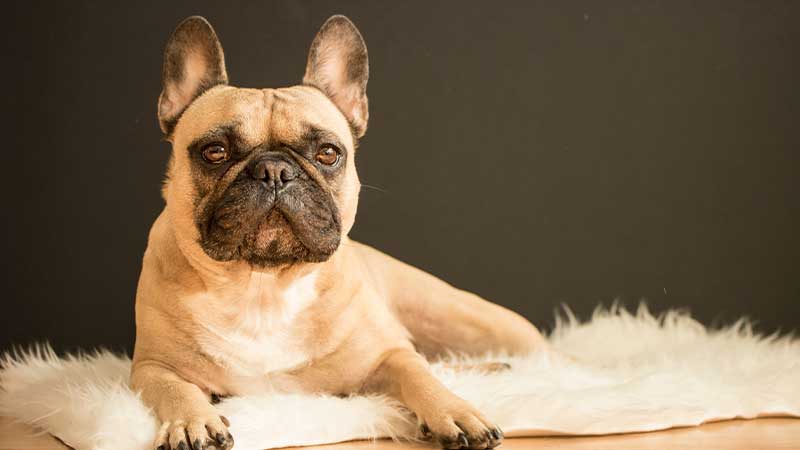
Fawn color is common among dog breeds, including Boxer, Beagle, etc. However, there’s a broad spectrum, from light fawn to red fawn and dark fawn. Some variations offer the best of two fur colors, creating rare colored French Bulldogs.
For example, the Fawn Brindle French Bulldogs rock brindle patterns overlay the predominant fawn hairs for a distinctive and appealing appearance.
Also, the Blue Fawn Frenchies sport a rare dynamic coat color. The base fawn coat is diluted with the blue gene, which results in its beautiful bluish-gray appearance.
They usually come in a solid color with no signature patches or spots on their fawn coat. But finding one with a dark muzzle or subtle markings around the ears and head is not atypical.
5. Chocolate Frenchie
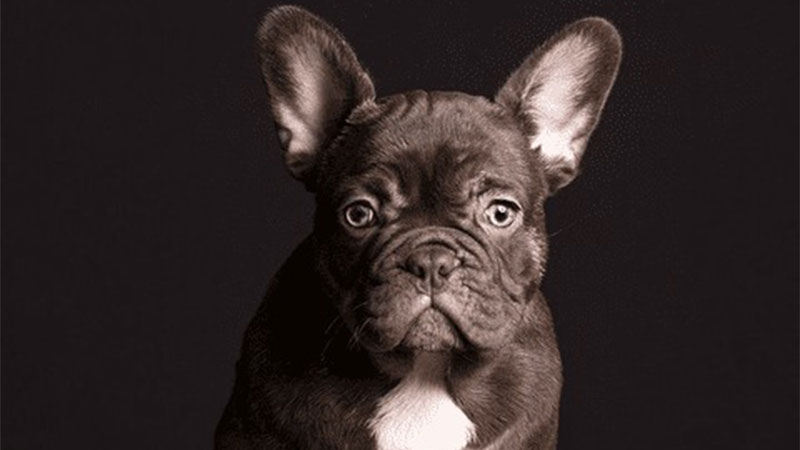
This is self-explanatory. Chocolate French Bulldogs can sport any of the shades of brown as the base coat color, from light to extremely dark. This unique puppy can come in solid fur color only or accentuate by some pattern such as brindle, tan, etc.
Nonetheless, the chocolate gene is considered one of the rarest in the world, which explains why these puppies can cost an arm and leg.
6. Blue French Bulldogs
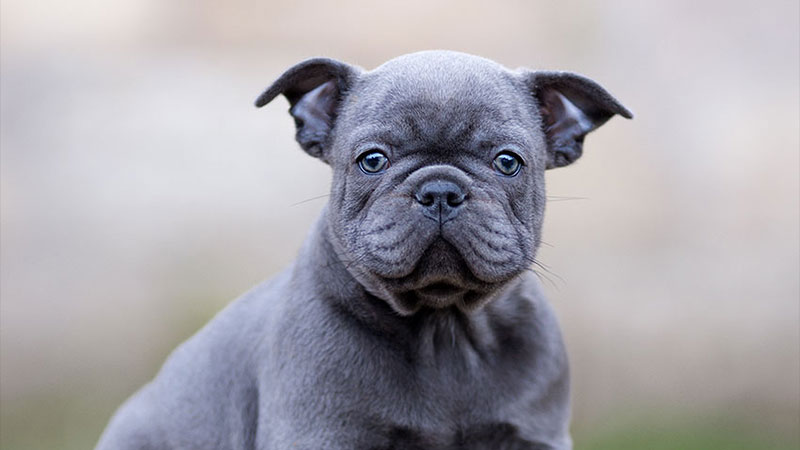
Blue French Bulldog puppies carry the recessive gene to give them that shiny bluish coat. They are the most popular rare french bulldog color due to several celebrities showing them off online. This also explains why it’s not an AKC French Bulldog and not qualified for dog shows.
Up till now, the demand for these beautiful Blue Frenchies keeps surging, leading to breeders being irresponsible and overproducing them. The result? Different variations of its lush coat and eye color emerged.
The blue coat, actually grayish blue, is now available in different hues: from light blue/silver to really dark blue. Also, these “mouse” dogs, as popularly referred to, have an extensive range of eye colors, from light to turquoise blue.
In addition to that, not all Blue Frenchies come with a solid color fur. Some puppies have white markings and different nose colors, contributing to their distinctive characteristics.
All in all, the Blue Frenchies are a treat to the eyes. They are very expressive, especially those with blue eyes. Sadly, their price tag can be pretty expensive, even if you are lucky enough to come across one.
7. Lilac French Bulldog
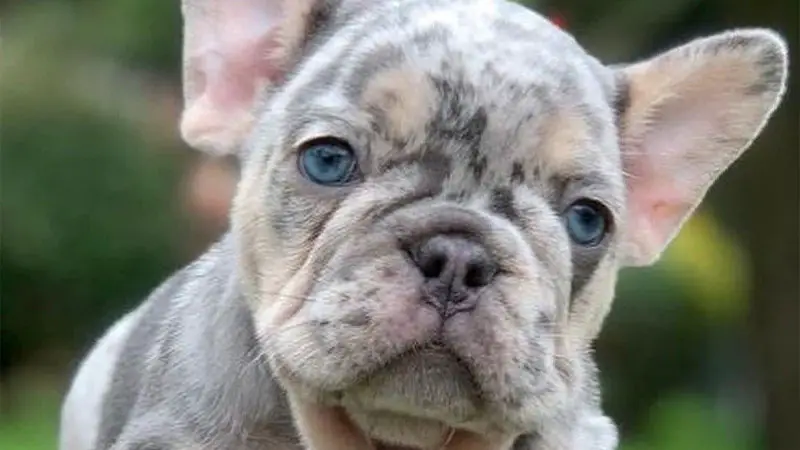
I bet you haven’t encountered a Lilac French Bulldog; that’s how rare this clown is. And, here’s why: this dog inherits two seldom-seen genes – Blue and Chocolate Frenchies.
The rare coat color, lilac, is due to further dilution of the chocolate gene by the dilute gene responsible for creating Blue French Bulldog. This genetic mutation leads to low amounts of melanin, which is needed to protect their skin, hair, and eyes against the sunlight.
Consequently, they have light-colored eyes with a grayish or bluish tint. Likewise, the paws and nose pads are also somewhat pink due to skin burns.
However, it’s easy to mistake the Lilac Frenchies for the Isabella French Bulldogs. Both feature similar genetic mutations, but Isabella Frenchies have a more grayish coat hue.
8. Merle French Bulldog
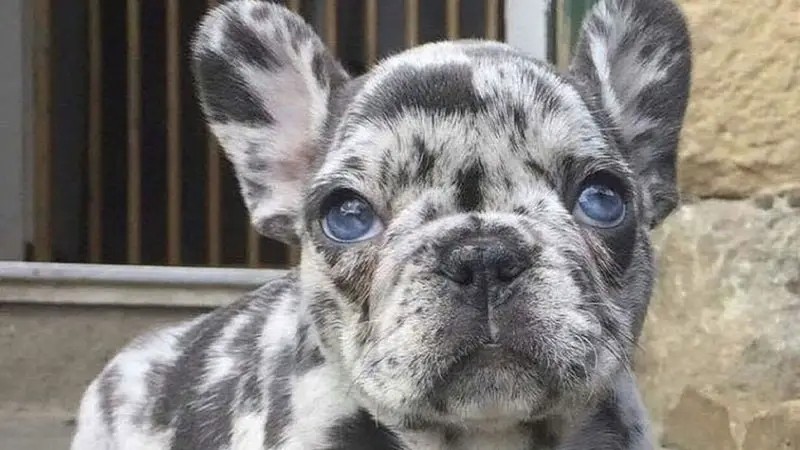
Merle is another exotic French Bulldog color that takes work to come by. These puppies are characterized by multiple tiny spots. You must know merle dogs are quite different from Pied Bulldogs.
These spots or markings come in a wide range of colors like tan, black, lilac, and blue. Thus, it’s often used to name these puppies, such as blue merle, tan merle, etc.
The merle gene is nearly as rare as the blue and chocolate gene, not because it has a tricky breeding process. Dog owners are skeptical of Merle Frenchies, especially if it’s not from a reputable breeder. Pups inheriting two instead of one merle gene are prone to several medical conditions like color dilution, alopecia, deafness, blindness, and many more.
9. Black and Tan

This French Bulldog is largely black with a couple of tan markings on the chest, neck, ears, and face — the exquisite blend of black and tan results in puppies with unparalleled beauty. The number of tan markings a Frenchie features varies.
In addition, the shade of markings also varies, from light brown to dark brown. Although it’s not entirely black, this particular coat coloration is not readily available and pricier than the Standard French Bulldog.
Unlike Blue and Lilac French Bulldogs, Black-and-Tan puppies are less prone to costly health complications.
10. White French Bulldog

These puppies rock a luster white coat and are equally rare to find. It’s important that you don’t confuse the White French Bulldogs with the Pied Frenchies. The formal does not feature large-sized patches on the head, neck, or ear. However, some puppies might have some markings or dark patterns adding subtle contrast to their pure white coat, but not in large sizes like the pied clowns.
Why AKC Rejects Rare French Bulldog Colors?
The American Kennel Club currently accepts ten colors, which are fawn, cream, and white, and their variations. Also, this breed standard is particular about markings. Frenchies with white markings, piebald, brindle markings, black masks, or ticks are qualified.
These colors and markings were common for French Bulldogs at the time of writing the AKC breed standard. The physical attributes have remained consistent for many years. Meaning, these genetic codes stayed dominant.
On the flip side, rare physical features are due to the breed carrying the recessive gene codes resulting from a genetic mutation. The AKC is yet to recognize them for now but might do so in the future, considering the sheer number of coat colorations making it to the forefront.
How to Care For Your French Bulldog’s Coat
There are several underlying reasons for skin and coat disorders, from hormone imbalance to infections. Hence, taking proper care of your French Bulldog’s coat is crucial. This includes:
- Showering or bathing your dog at least once weekly for a healthy coat and overall cleanliness. It’s important to bathe him less frequently to avoid depleting his coat and skin’s essential oil, causing dullness, and skin irritation, among many things.
- Apply non-irritating moisturizing shampoo to moisturize the hair. Afterward, condition the pet hair with any vitamin E-enriched dog conditioner.
- Include sardines, tuna, or salmon for healthy fatty acids in your dog’s foods. Also, you can give him tiny bits of supplements for nourishment.
- Most importantly, feeding him a high-quality protein meal is paramount since his coat is mainly made up of protein.
- Additionally, if you plan to mix coconut oil or others into his food to prevent hair damage and itching skin. It’s best to add only a tiny amount to avoid diarrhea.
FAQs
Is Isabella French Bulldog the most expensive?
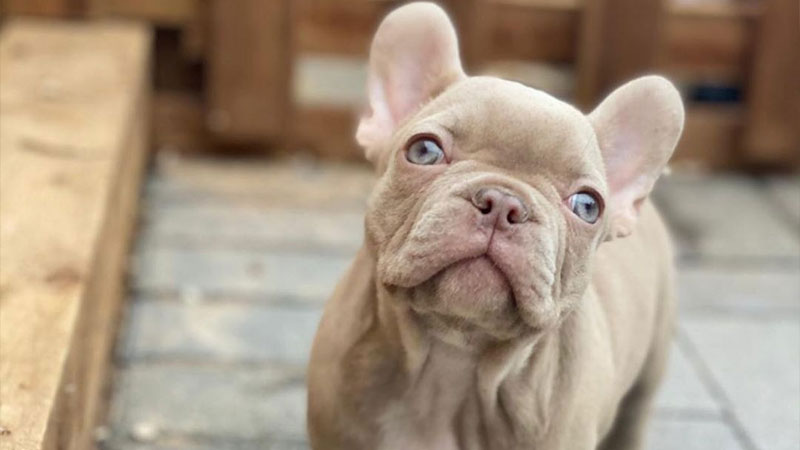
This Frenchie is currently the rarest and most expensive, costing up to 5 figures. The reason for its scarcity and high price tag is its genetic mutation involving two copies of rare genetic codes from the Blue Frenchie and Chocolate French Bulldog. Not only that, it takes an enormous amount of effort and time.
Plus, these puppies go through genome mapping tests to ensure their rare colors are from their genetic standpoint. This is another reason why the Isabella French Bulldog is so expensive.
Is tan among the rare French Bulldog colors?
When it comes to French Bulldog markings and colorations, tan, unlike white markings, is rare. You can get a puppy with a tan marking on a standard French Bulldog with a bit of patience and extra dough.
Remember that Tan French Bulldogs become rarer and more expensive if the coat coloration is one of those exotic french bulldog colors like black.
What are the common French Bulldog colors?
Pied, fawn, and brindle are popular coat patterns and colors. Getting a puppy with a light grey, the darker brown, blue, and golden coat is not extremely challenging. It’s important to note that Frenchies are adorable animals regardless of their color.
Does any breed standard recognize the merle French Bulldog?
Most breed standards, including the AKC and United Kennel Club (UKC), do not welcome Merle Frenchies. Despite having an eye-catching blotchy coat appearance, the merle gene is dangerous. For this reason, most responsible breeders do not recommend the merle bulldog or its variations to avoid expensive vet bills.
Any known health issues with Merle French Bulldogs?
This exotic furry friend is highly sought after for its breathtaking merle coat pattern caused by a rare genetic disorder. This abnormality is also the underlying culprit for immunological problems, hip dysplasia, and allergies faced by these loving hairy pals. Another thing to note, a Merle Frenchie with light-colored eyes is more prone to several eye anomalies like cataracts.
Conclusion: Is the French Bulldog Color Really Important?
If you are not looking to compete in one of the dog shows, the French Bulldog colors should not be a crucial deciding factor when adopting or purchasing these playful clowns. Temperament, health, and overall well-being of the puppy should be your primary concern.
Thus, purchasing this petite dog from reputable breeders known for the best breeding practices is imperative. Otherwise, you might have a gorgeous puppy with many health challenges and eventually have to put him down – a sad reality.
Undoubtedly, French Bulldogs with merle, white fawn, tan blue, light brown, blue fawn, or other rare colors look elegant and irresistible. Still, it doesn’t make these beloved animals more or less loyal and wonderful companions.
Please note that while the French Bulldog colors mentioned in this article may exist within the breed, they may not be recognized by all breed standards. Also, while some French Bulldog colors may be the result of crossbreeding with other breeds, they are still recognized as French Bulldogs by many breed standards. We recommend consulting with a reputable breeder or breed club to determine which breed and color is right for them.

The best bulldog is the dog that doesn’t boss it’s owner constantly trying to get what they want to do.
Absolutely agree!!.
What about the ones that don’t boss, but are way to cute and makes it hard to resist giving in? That being said, we are both well trained and my girl rarely has unreasonable requests. She doesn’t balk much or very long when I stand firm.
These aren’t rare, or worth more. They’re crossbred for “designer colours”, meaning the backyard breeders is not pushing to meet the standard, and has no proof of their commitment to healthy bulldogs. They are a breed with a history of major health issues, and it’s these backyard breeders crossbreeding for $$$ that are having a huge impact on our health.
Please, do the ethical thing and don’t encourage this behaviour.
Oh gosh, I’m tired and didn’t read the article through… You did address the health issues, and I take back what I said – since the Frenchie becoming number 1 dog, there’s been more articles promoting the designer colours. I apologise, and thank you for what is a well written article. I’ll get off the internet now!
The issue with merle is that French bulldogs were mixed with another breed to get the color. Unethical breeders breed for color and charge higher prices for “rare” (out of standard) colors.
A dog being merle doesn’t mean it’s unhealthy, but buying from a breeder that doesn’t health test (there are tests that are recommended by the breed club) is problematic.
I’m glad you mentioned merle x merle breeding, and that double merlse can cause deafness and blindness.